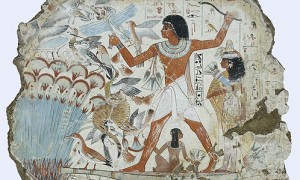- Stunning images of Earth from space. Direct agricultural (biodiversity) interest at 3, 6 and 15.
- A cheese that’s full of agrobiodiversity. In more ways than one.
- Agrobiodiversity useful in space. And from space.
- Biodiversity in Africa. Agriculture mentioned, and not just in a bad way. Nice maps too.
- Eggplants. Agrobiodiversity. Cooking. Sex. Video.
- Sad story of a farmer losing his cows. Not just cows, “the oldest pure breed on Earth.”
- Farmers bred colourful pigs for the sheer hell of it.
- CABI blog reviews 2008.
- Keeping oysters healthy is hard.
- Legendary breeder Khush says organic rice not a good idea.
- Variation Under Domestication. Darwin’s Origin blogged.
Nibbles: Wheat, Cotton, Dogs
From strip to quilt
How Jethro Tull changed English farming and landscape. No, not the band.
Nebamun redux
One — or at least part of one — of the great agrobiodiversity-themed art works of the ancient world is back. Apart from “Fowling in the marshes,” reproduced below, Nebamun’s painted tomb includes representations of a garden pool, wine-making, and food offerings.

Photograph: The British Museum
Videos on traditional food systems
The Centre for Indigenous Peoples’ Nutrition and Environment (CINE) based in McGill University, Canada, responded to requests from indigenous leaders from around the world to help stop loss of traditional food system knowledge with research and community-driven activities that bridge the generation.
This series of videos presents highlights from 12 indigenous community areas in 9 countries, and is intended to con tribute to the evidence base used to make global policies to protect Indigenous Peoples’ food resources and promote good health.
Thanks to Lois Englberger for the tip.